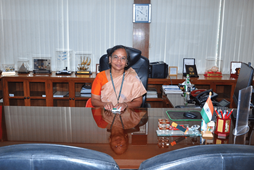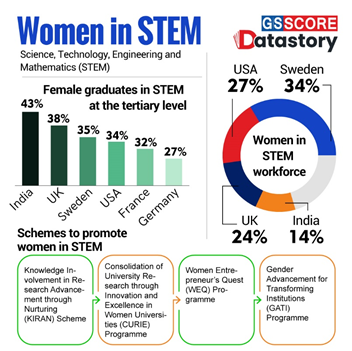

“The idea of perfect womanhood is perfect independence. There is no hope of rise for that family or country where there is no estimation of women, where they live in sadness.”
- Swami Vivekananda
Introduction:
- The worth of a civilization can be judged by the place given to women in society. One of several factors that justify the greatness of India's ancient culture is the right place granted to women.
- At the same time, there exists a dichotomy as when we trace the pages of history nowhere men and women were treated alike and assigned the same status. Women have been always fighting for their rights and position in society.
- They have several times urged for equality so that they can lead a life exactly on par with men. If talking about the women’s status in Independent India, then it has surely improved. But the journey hasn’t been a smooth ride.
The recent appointment of a woman scientist (Dr. N Kalaiselvi) as the director general of the Council of Scientific and Industrial Research (CSIR) for the first time in the history of the 80-year-old R&D organization brings to the fore the continuing challenges in getting more women into the country’s science and research endeavors.
The changing status of women in Indian Society
- It was a natural outcome of the subjugation of women that woman was relegated to a plaything of man, an ornament to decorate the drawing room. Serving, knitting, painting, and music were her pastimes, and cooking and cleaning her business.
- Post-independence, the Indian Constitution has given women “equal status” to men.
- There is no discrimination between men and women or any gender per se. All professions are open to both of them with merit as the only criterion of selection.
- As a result of their newly gained freedom Indian women have distinguished themselves in various spheres of life as politicians, orators, lawyers, doctors, administrators, and diplomats.
- They are not only entrusted with work of responsibility but also, perform their duties very honestly and sincerely. There is hardly any sphere of life in which Indian women have not taken part and shown their worth. Women exercise their right to vote, contest for Parliament and Assembly, seek appointment in public office, and compete in other spheres of life with men. This shows that women in India enjoy today more liberty and equality than before.
- They have acquired more liberty to participate in the affairs of the country. They have been given equality with men in shaping their future and sharing responsibilities for themselves, their family, and their country.
- Modern-day women are independent, take the right decisions boldly, stand up for their rights, and walk the path of success. Kalpana Chawla, Indra Nooyi, Gita Gopinath, and many more women achievers are prime examples.
|
Contemporary examples of Social Change A Case of Mewat (Nuh District):
|
Women in the field of Education
- After Independence, the educational rights of women were promoted and they were made aware of the value of education.
- The ratio of women pursuing higher studies and taking education improved gradually since then.
- The government provided several benefits to women such as scholarships, loan facilities, hostel facilities, etc. who wished to go out to pursue higher education. By getting such benefits a large number of women are able to pursue higher education today.
Women in Science:
- Data compiled by the Department of Science and Technology (DST) shows that 28% of participants in extramural Research & Development projects in 2018-19 were women, up from 13% in 2000-01 due to various initiatives are taken by successive governments.
- According to the All-India Survey on Higher Education (AISHE) 2019, 53% participation of women in science education at the Bachelor's and 55% at the Master’s levels respectively.
- First woman director general of CSIR: The appointment of a woman scientist (Nallathamby Kalaiselvihas) as the director general of the Council of Scientific and Industrial Research (CSIR) for the first time in the history of the 80-year-old R&D organization brings to the fore the continuing challenges in getting more women into the country’s science and research endeavor.
- Nallathamby Kalaiselvihas rose through the ranks in CSIR and had broken the proverbial glass ceiling by becoming the first woman scientist to head the Central Electrochemical Research Institute (CSIR-CECRI) in February 2019.

|
Nearly 43 percent of the total graduates in STEM in our country are women, which is considerably higher than in developed nations like the US (34 percent), UK (38 percent), Germany (27 percent), and France (32 percent). But the percentage of women engaged in STEM jobs in the country is relatively low—14 percent as compared to the global average of 28 percent. |
Reasons for the gender gap in science, technology, engineering, and mathematics (STEM)-related fields:
- Mindset: A major factor responsible for this is the mindset that boys are better at science and girls are not. Women are still considered less efficient than men when it comes to STEM-related fields is a major misconception.
- Fewer role models: Role models many times are a factor in making career choices. However, there are fewer female role models in the fields of science, math, or engineering for young female students to follow. Moreover, our textbooks too rarely talk about these role models.

- Fewer women-specific science institutes: Only 11% of colleges in India which are exclusively for women, the majority of which offer arts and commerce rather than science.
- Patriarchy: When comes to the question of pursuing a career in science, the entrenched patriarchy in society holds women back. There are patriarchal attitudes in hiring practices or awarding fellowships and grants etc. A male-dominated work environment and gender insensitivity are additional burdens for women scientists.
- Economic factors: This is another major constraint for women in pursuing science. Even for families with greater resources, economic considerations affect the pursuit of a science degree as a science which is generally more expensive than an art or a commerce degree.
- Considered as Burden: Families expect daughters to marry and assume obligations to their husband’s families. Many families think that a daughter’s education would primarily benefit her in-laws rather than her natal family. Such families traditionally view boys’ education differently from girls.
- Other reasons: Gender bias at the workplace, want of equal pay, recognition, and lucrative opportunities, expectations to follow traditionally ‘feminine’ roles at home, and the pressure to conform to patriarchal societal norms.
Government Initiatives Taken for Women in Science:
- Gender Advancement for Transforming Institutions (GATI): The Gender Advancement for Transforming Institutions (GATI) was launched by the Department of Science & Technology (DST). It will develop a comprehensive Charter and a framework for assessing Gender Equality in STEM (Science, technology, engineering, and mathematics).
- Vigyan Jyoti Scheme: Vigyan Jyoti Scheme is launched by the Department of Science & Technology (DST). It is intended to create a level-playing field for the meritorious girls in high school to pursue Science, Technology, Engineering, and Mathematics (STEM) in their higher education.
- Indo-US Fellowship for Women in STEMM (WISTEMM) program: Women scientists can work in research labs in the US.
- Consolidation of University Research for Innovation and Excellence in Women Universities (CURIE) Programme: Improving R&D infrastructure and establishing state-of-the-art research facilities in order to create excellence in S&T in women's universities.
- Knowledge Involvement in Research Advancement through Nurturing (KIRAN): Department of Science & Tech. restructured all women-specific programs under one umbrella called KIRAN. The mandate of the KIRAN program is to bring gender parity to S&T through gender mainstreaming.
- One of the programs under the scheme — ‘Women Scientist Scheme’ — provides career opportunities to unemployed women scientists and technologists, especially those who had a break in their careers.
- Women's technology parks: Women's technology parks (WTPs) act as a single window hub for the convergence of diversified technologies, leading to the socio-economic development of women through capacity building and the adoption of location-specific technologies.
Government push for Women Empowerment:
- For an Indian woman, freedom does not just mean those guaranteed under the Constitution. To ensure women are empowered, the government and the public sector need to play important roles to enable their welfare in various sectors. A slew of schemes has been launched in recent years to empower women to be independent in their lives. Six of the most important ones are:
- Beti Bachao Beti Padhao Yojana: It was launched on January 22, 2015, in Panipat, Haryana, with the aim to generate awareness and also improve the efficiency of welfare services for the girl child. The initial aim of the campaign was to address the declining Child Sex Ratio (CSR) but has come to include gender-biased sex-selective eliminations, and propagating education, survival, and protection of the girl child.
- Mahila-E-Haat Under the purview of the Ministry of Women and Child Development, the government launched Mahila-E-Haat in 2016. It is a bilingual online marketing platform that leverages technology to help aspiring women entrepreneurs, self-help groups, and NGOs to showcase their products and services.
- Mahila Shakti Kendra: The government launched the Mahila Shakti Kendra in 2017 to empower rural women with opportunities for skill development, employment, digital literacy, health, and nutrition. The Mahila Shakti Kendras will work through community engagement through student volunteers in the 115 most backward districts.
- Working Women Hostel: The government launched the Working Women Hostels to ensure the availability of safe, convenient accommodation for working families, along with daycare facilities for their children, wherever possible in urban, semi-urban, and rural areas.
- Support to Training and Employment Programme for Women (STEP) The STEP scheme was set up to provide skills to women so that they can take up gainful employment. It also provides the right competencies and training for women to become entrepreneurs. Open to every woman above the age of 16, it is run through a grant given to an institution/organization including NGOs directly.
- Sukanya Samriddhi Yojana: Falling under the ambit of the Beti Bachao Beti Padhao scheme, the Sukanya Samriddhi Yojana is a government-backed savings scheme for girl children. The account can be opened at any India Post office or a branch of an authorized commercial bank anytime between the birth of the girl child and the age of 10 by a parent or guardian.
Conclusion:
The modern woman has started caring for her social, emotional, cultural, religious, and economic needs. She has now become a tool for social change in India. It can be said that women have more freedom than earlier however not true in many respects because prejudice still remains in society. The consciousness has not only made all of us more sensitive to the situation of half the country’s population but has also generated a lot of data, studies, and reports on relevant issues. It can also be hoped that it will help to correct stereotyping of women and their role and therefore carry a positive impact on status.
Related Articles


